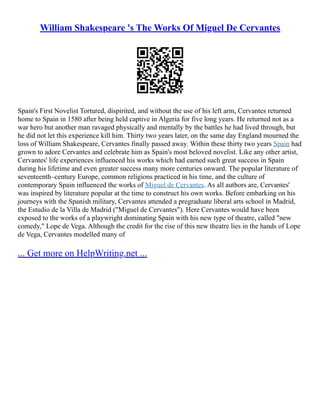Lope de Vega was a renowned Spanish playwright during the Golden Age of Spanish literature who helped establish the rules and conventions of comedia plays. He wrote over 1,800 plays, more than any other author in any language, addressing topics ranging from history and religion to comedy and romance. De Vega discussed the three disciplines of comedy, tragedy, and history in his treatise New Art of Making Plays, establishing him as one of the most influential figures in early modern Spanish theater.
![Comedias In Spain
Similarly to England, Spain also experienced a resurgence in theatre. During the Spanish Golden
Age, which encompassed 100 years from 1550 to 1650, Spain's economic boom allowed the craft of
theatre to flourish. Through this age, Spanish theatre would see distinct developments in the subject
matter of productions, the layout of theatre venues, and its catalog of native playwrights.
Though the nation remained widely Catholic and continued to produce many religious plays, the
golden age would also host a wave of secular dramas called comedias. Comedias were full–length,
three–act plays, unique not in their dramatic structure, but in their subject matter. Comedias tended
to deal in the melodrama, many times commenting on abstract concepts of ... Show more content on
Helpwriting.net ...
Spaniards did not reinvent the wheel in the creation of theatre venues. It resembled conventional
English theatres of the time, with the stage and seating being built around existing courtyards. These
open–air courtyard theatres were known in Spain as corrales (Wilson and Godfarb 318). However,
Spanish theatres hosted characteristic structures within the corrales. Toward the back would be an
alojera that sold food and drinks similarly to today's concession stands (Wilson and Godfarb 319).
Additionally on the back wall of the venue, above the general playgoers, there would be a cazuela. A
cazuela was an intentionally isolated seating gallery, complete with its own entrance into the theatre,
intended for the unescorted women viewing the show (Wilson and Godfarb 319). Although the
treatment of women patrons seems antiquated, Spanish acting companies were actually more
inclusive than other regions of the Renaissance. Further distancing themselves from their
Elizabethan counterparts, "women were allowed to act, the inclusion of women... an outgrowth of
[English] custom" (Wilson and Godfarb
... Get more on HelpWriting.net ...](https://image.slidesharecdn.com/comediasinspain-231119170752-505f92dc/85/Comedias-In-Spain-1-320.jpg)
























































































![The Role of Women in Fuenteovejuna Essay
Lope de Vega's play touches upon several key components and ideas that were brought up in many
of the other stories read throughout the semester. This included the role of gender and how men and
women are viewed differently in the Spaniard town of Fuenteovejuna. Another topic included the
importance of family, love, and relationships and their connection on loyalty, trust, and personal
beliefs. The last major influence found in other literature and in Fuenteovejuna, were the political
and religious references made throughout the play. Even though Lope de Vega didn't make these
views obvious, the reader could still pick up on their connotation and the references made towards
these specific ideas. With all of this in mind, each of these ... Show more content on Helpwriting.net
...
The importance of where a person comes from influences their views on other people. Even later on,
the peasants from Fuenteovejuna refer to lineage and how they may not come from a great and
well–known line of blood but their personalities and other characteristics worth praising become just
as significant to these people. However it still has some effect on them. This brings up the topic of
self–value and self–dependency from an overlord and the ability to think for one's self. This self
power revolves around the political and social period at the time, with the transition of the common
person becoming to voice their opinions and somewhat choose what they want to believe in. The
sense of community is built upon the farmers of Fuenteovejuna. Their views of one another and how
they act with one another reveals a tight knit community. In one critics analysis of Fuenteovejun,
"They[The peasants] believe that honor on its most basic level belongs to everyone because all
belong to the same society and all are children of God. People can, of course, lose or squander their
honor..." (Blue 306) Lope de Vega incorporates his understanding and his own personal view on
how the world should be viewed. He uses the peasants and how they interact with one another to
describe this ideal and way of living. Through their words he understands humans shouldn't
disregard one another due to class
... Get more on HelpWriting.net ...](https://image.slidesharecdn.com/comediasinspain-231119170752-505f92dc/85/Comedias-In-Spain-90-320.jpg)











